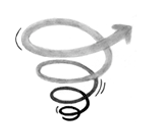 In The Upward Spiral (New Harbinger Publications, 2015), UCLA neuroscientist Alex Korb demystifies the intricate brain processes that cause depression and offers a practical and effective approach to getting better. Based on the latest research in neuroscience, he offers multiple tips for rewiring the brain, altering its chemistry, and in so doing, creating an upward spiral towards a happier, healthier life.
In The Upward Spiral (New Harbinger Publications, 2015), UCLA neuroscientist Alex Korb demystifies the intricate brain processes that cause depression and offers a practical and effective approach to getting better. Based on the latest research in neuroscience, he offers multiple tips for rewiring the brain, altering its chemistry, and in so doing, creating an upward spiral towards a happier, healthier life.
Korb notes numerous studies employing functional magnetic resonance imaging (fMRI) — a technique that uses MRI technology to measure brain activity by detecting changes associated with blood flow. Based on the findings of these studies, he suggests several steps one can take to calm an agitated limbic system, when experiencing such emotions as guilt, shame, anger, worry, anxiety.
In neuroscientific language, these steps, or ritual behaviors, increase activity in the medial prefrontal cortex and decrease activity in the amygdala, thereby reducing depression.
1. Express gratitude
“Despite their differences, pride, shame, and guilt all activate similar neural circuits, including the dorsomedial prefrontal cortex, amygdala, insula, and the nucleus accumbens. Interestingly, pride is the most powerful of these emotions at triggering activity in these regions — except in the nucleus accumbens, where guilt and shame win out. This explains why it can be so appealing to heap guilt and shame on ourselves — they’re activating the brain’s reward center.”
Expressing gratitude acts on the same reward centers in the brain — with better long-term results. Feeling grateful activates the brain stem region that produces the neurotransmitter dopamine. Additionally, gratitude toward others increases activity in social dopamine circuits, which makes social interactions more enjoyable. And like Prozac, gratitude boosts the neurotransmitter serotonin.
In action, expressing gratitude to the people you care about most creates a positive feedback loop in your relationships.
2. Label negative feelings
Give bad feelings a name. fMRI studies (Gross; Kevin Oschsner) have shown that suppressing negative emotions may look fine outwardly, but the limbic system remains as aroused as ever, and in some cases, even more aroused.
Labeling or describing the negative emotion, on the other hand, makes a big difference; in using symbolic language (brief descriptions, metaphors, metrics, and simplifications of our experience) we activate our prefrontal cortex, which reduces the arousal in the limbic system. (Interestingly, labeling is a fundamental tool of mindfulness.)
3. Make a decision
Brain science shows that making decisions (including creating intentions and setting goals) engages the prefrontal cortex in a positive way, and calms the limbic system.
In making a decision, however, Swarthmore professor Barry Schwartz advises us to go for “good enough” rather than “best decision ever made on Earth.” Trying for the best, instead of good enough, brings TOO much emotional ventromedial prefrontal activity into the decision-making process; in contrast, recognizing that good enough is good enough activates more dorsolateral prefrontal areas, which helps us feel more in control.
4. Touch people (discriminately!)
fMRI experiments have indicated that social exclusion activates the same pain and worry circuitry (activation in the insula, anterior cingulate, and dorsolateral prefrontal cortex) as physical pain does. When we are touched, however, there is reduced activation in both the anterior cingulate cortex and dorsolateral prefrontal cortex — that is, less activity in the pain and worrying circuits.
Touching people we are close to (LONG hugs, not quickies!) releases the hormone oxytocin, which reduces the reactivity of the amygdala.
Research indicates that for those who have no intimate partner in their lives, regular massages can successfully decrease stress hormones by activating painkilling endorphins, raising serotonin and dopamine levels, and decreasing the stress hormone cortisol.
* * *
Dr. Korb reminds us that everything is interconnected. Gratitude improves sleep. Sleep reduces pain. Reduced pain improves your mood. Improved mood reduces anxiety, which improves focus and planning. Focus and planning help with decision making. Decision making further reduces anxiety and improves enjoyment. Enjoyment gives us more for which to be grateful, keeping that loop spiralling upward.